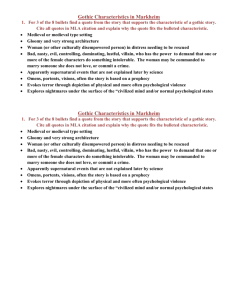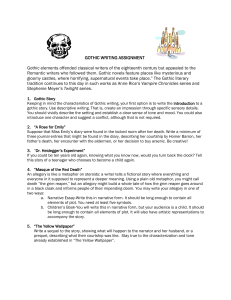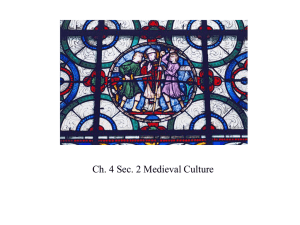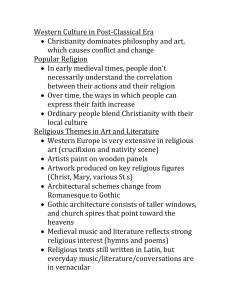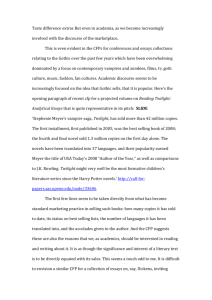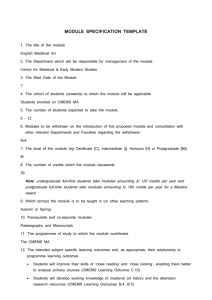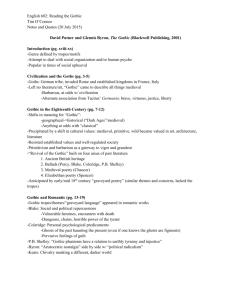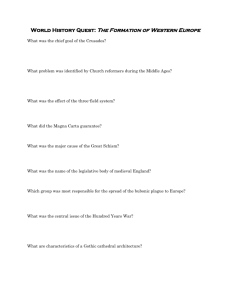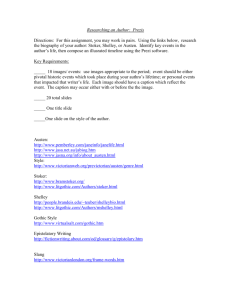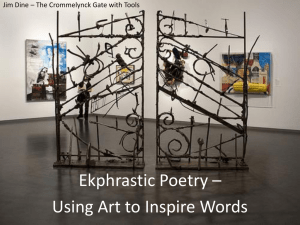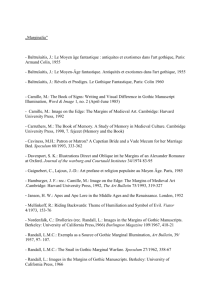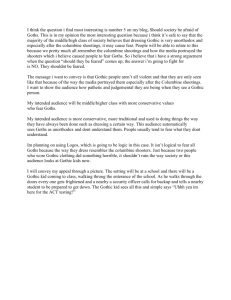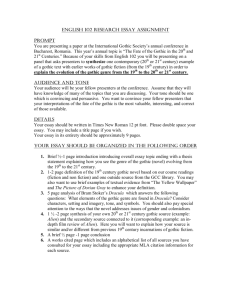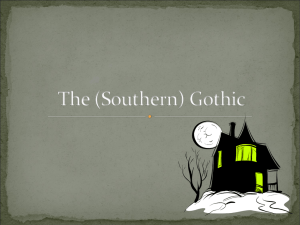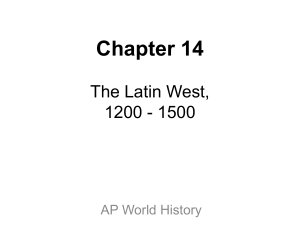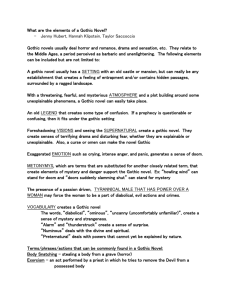University of Kent at Canterbury
advertisement
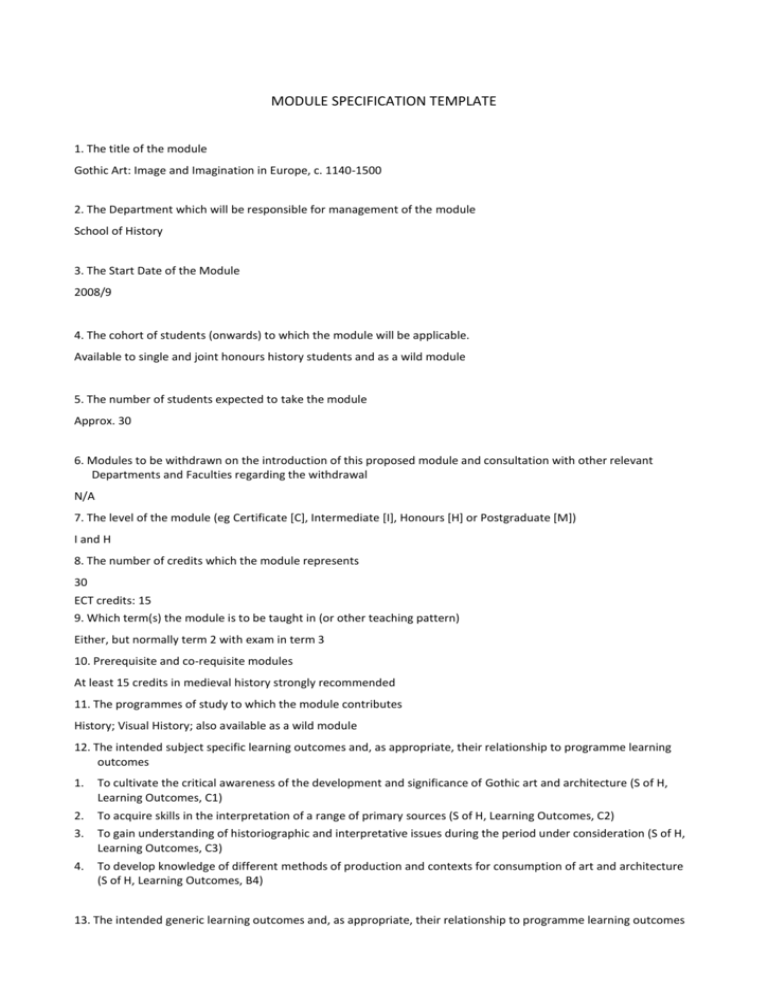
MODULE SPECIFICATION TEMPLATE 1. The title of the module Gothic Art: Image and Imagination in Europe, c. 1140-1500 2. The Department which will be responsible for management of the module School of History 3. The Start Date of the Module 2008/9 4. The cohort of students (onwards) to which the module will be applicable. Available to single and joint honours history students and as a wild module 5. The number of students expected to take the module Approx. 30 6. Modules to be withdrawn on the introduction of this proposed module and consultation with other relevant Departments and Faculties regarding the withdrawal N/A 7. The level of the module (eg Certificate [C], Intermediate [I], Honours [H] or Postgraduate [M]) I and H 8. The number of credits which the module represents 30 ECT credits: 15 9. Which term(s) the module is to be taught in (or other teaching pattern) Either, but normally term 2 with exam in term 3 10. Prerequisite and co-requisite modules At least 15 credits in medieval history strongly recommended 11. The programmes of study to which the module contributes History; Visual History; also available as a wild module 12. The intended subject specific learning outcomes and, as appropriate, their relationship to programme learning outcomes 1. To cultivate the critical awareness of the development and significance of Gothic art and architecture (S of H, Learning Outcomes, C1) 2. To acquire skills in the interpretation of a range of primary sources (S of H, Learning Outcomes, C2) 3. To gain understanding of historiographic and interpretative issues during the period under consideration (S of H, Learning Outcomes, C3) 4. To develop knowledge of different methods of production and contexts for consumption of art and architecture (S of H, Learning Outcomes, B4) 13. The intended generic learning outcomes and, as appropriate, their relationship to programme learning outcomes 1. 2. 3. Students will develop their ability to communicate about complex concepts effectively (S of H, Learning Outcomes, B1-4) Students will gain awareness of the historical importance of visual sources and the ability to relate these to documentary and secondary sources (S of H, Learning Outcomes, A1-2, B3) Students will develop their ability to assess the strengths and limitations of sources, both visual and written (S of H, Learning Outcomes, A3) 14. A synopsis of the curriculum In early 1140s, the venerable abbey of St Denis was rebuilt by Abbot Suger in an astonishing new architectural style: Gothic. With its soaring stone vaults and expansive windows filled with magnificent stained glass, St Denis inspired ambitious buildings across Europe. At the same time, equally impressive developments were taking place in painting, manuscript illumination, sculpture, metalwork, and other media. This course traces the development of the Gothic style, investigating the social, intellectual, theological and especially the imaginative context for its development. Organised chronologically, the course will investigate the emergence of professional artisans and their organisation into guilds, and consider a range of practical issues including how they were trained, the materials they used, how they used pattern books to develop, record and exchange ideas. We will consider how the taste of an expanding class of lay patrons was shaped by factors including the coming of the Friars, rising literacy levels, and an influential courtly culture. We will ask what roles the visual arts played in the Middle Ages, and consider how a single object could be a focus for devotion as well as an expression of aristocratic splendour. 15. Indicative Reading List Michael Camille, The Gothic Idol: Ideology and Image Making in Medieval Art (1989) Nicola Coldstream, Medieval Architecture (2002) Veronika Sekules, Medieval Art (2001) T. G. Frisch, Gothic Art 1140-c. 1450: Sources and Documents (1987) Paul Binski, Becket’s Crown: Art and Imagination in Gothic England (2004) 16. Learning and Teaching Methods, including the nature and number of contact hours and the total study hours which will be expected of students, and how these relate to achievement of the intended learning outcomes This course will consist of a lecture and a two-hour seminar each week. Students will be expected to prepare for each seminar by reading set texts and examining images (S of H, Learning Outcomes, D5), and will demonstrate their knowledge and understanding each week by delivering a short presentation on a set topic (S of H, Learning Outcomes, D1). This preparation will develop their understanding of the historical context for narrative art and interpretative scholarly issues as outlined above, §11, 1-3. Additionally, each week every student will be assigned a task in relation to the primary sources, which will be presented to the class and subsequently submitted in writing to the module convenor (S of H, Learning Outcomes, C2). 17. Assessment methods and how these relate to testing achievement of the intended learning outcomes This course will be assessed by a final exam, worth 40%, which will test students’ grasp of the course’s key works and themes. Coursework will consist of one essay, worth 40% of the coursework mark, addressing a broad theme, and another that focusing on a specific work of art, normally selected by the student from the collections of the Victoria & Albert museum in London (60% of the coursework mark). The first assignment is intended to help the students to deploy their experience writing history essays in an art historical context, and the second is intended to develop their ability to interpret a work of art as a primary source set within a robust historical and interpretative context. Normally ‘I’ and ‘H’ modules are distinguished on the basis that ‘H’ students will engage more fully with primary evidence than ‘I’ students; however, given the intensive focus on primary material throughout the course this is not appropriate here. Primary source analysis is a particular focus of the exam and essay 1 for both levels. Progression will be demonstrated by the higher burden on ‘H’ level students to demonstrate their ability to incorporate a critical appraisal of works of art and other sources with historiographic analysis. To this end, the examination for ‘H’ candidates will require students to include historiography within their responses. Exam = 40% Coursework = 60%, comprised of the following elements: Essay 1: 40% Essay 2: 60% 18. Implications for learning resources, including staff, library, IT and space Staff: This course will be taught by Dr Alixe Bovey. Library: Some recent publications may need to be acquired by the library. Some images may need to be purchased or scanned from 35mm slides already in the library’s collection. IT: Lectures and seminars will require access to a PowerPoint projector. Space: lecture theatre and seminar rooms with (with window blinds and a decent data projector) will be required for two hours each week. This course will take advantage of the resources of Canterbury Cathedral. 19. A statement confirming that, as far as can be reasonably anticipated, the curriculum, learning and teaching methods and forms of assessment do not present any non-justifiable disadvantage to students with disabilities As far as can be anticipated this course will not present any non-justifiable disadvantages to students with disabilities.
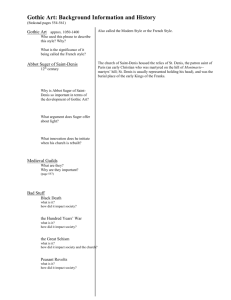

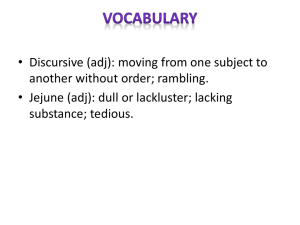

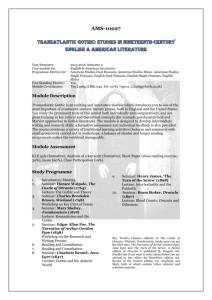
![MT803 [3] - University of Kent](http://s3.studylib.net/store/data/007457066_1-5fe137baf3cedc2e289b01a31bb45faf-300x300.png)
